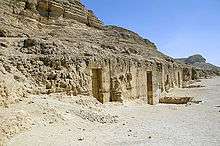Baqet III
Baqet III was an ancient Egyptian official and Great Chief of the Oryx nome (the 16th nome of Upper Egypt) during the 11th Dynasty in the 21st century BCE. Apart from the position of governor of the entire nome, Baqet III also held the titles haty-a, treasurer of the king of Lower Egypt, confidential friend, true royal acquaintance, and mayor of Nekheb.[1]
| Baqet[1] in hieroglyphs |
|---|
| Baqet III Nomarch of the 16th nome of Upper Egypt | |
|---|---|
 Outside of the tombs of Baqet III and of his son Khety at Beni Hasan | |
| Predecessor | Ramushenty |
| Successor | Khety? |
| Dynasty | 11th Dynasty |
| Pharaoh | Mentuhotep II |
| Father | Ramushenty |
| Children | Khety? |
| Burial | Beni Hasan tomb 15 (BH15) |
As a son of his predecessor Ramushenti,[2] he administered the governorate in the city of Men'at Khufu.[3]
Realizing that the fate of the civil war was definitely in favor of the Thebans led by Mentuhotep II, Baqet cunningly broke the long neutrality of his territory and took the Theban side.[3] After his death, his new loyalty allowed him to be succeeded by his probable son Khety and by his descendants until the time of Amenemhat I, when a family turnover took place in the governorship with the installation of Khnumhotep I.[2]
The tomb BH15
Baqet III was buried in the necropolis of his clan in Beni Hasan inside the tomb no. 15. The tomb is composed of a cult chapel and an inner burial chamber, and is well known for its remarkable paintings.[4]
The northern wall depicts Baqet and his wife in their daily life, the hunting of various animals including fantastic ones,[5] and various artisans whilst working.
The eastern wall shows a fortress garrisoned by Egyptians and besieged by a mixed army composed of Egyptians infantry, Nubian bowmen and maybe Libyan slingers,[3] likely representing a Theban offensive; on the same wall are also depicted an impressive number of wrestling positions and techniques.
Finally, the south wall mainly shows Baqet's funeral, but also some people playing senet.

References
- Newberry, P. E.; Griffith, F. L. (1893). "Tomb No. 15". Beni Hasan. Volume 2. London: Egypt Exploration Fund. pp. 41–50.
- Grajetzki, W. (2006). The Middle Kingdom of ancient Egypt: history, archaeology and society. London: Duckworth Egyptology. pp. 112–113.
- Hayes, W. C. (1971). "II. The Nomarchs of Middle Egypt". In Edwards, I. E. S.; Gadd, C. J. (eds.). The Cambridge Ancient History. Vol 1, Part 2. Early History of the Middle East (Third 2006 ed.). Cambridge: Cambridge University Press. p. 468−472. ISBN 0-521-077915.
- Description of Baqet III's tomb BH15
- Margaret Bunson, Encyclopedia of Ancient Egypt. Infobase Publishing, 2009, ISBN 1438109970, p. 64.
Further reading
| Wikimedia Commons has media related to Tomb of Baqet III (BH15). |
- Kanawati, N. and Evans, L. (2018). Beni Hassan. Vol. IV: The Tomb of Baqet III (ACE Reports 42). Oxford: Aris and Phillips.